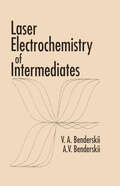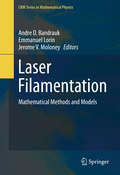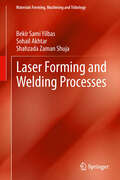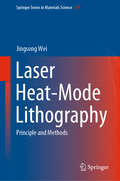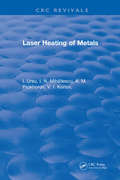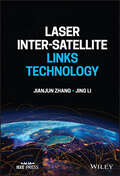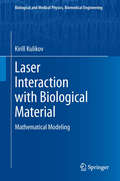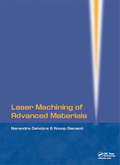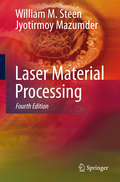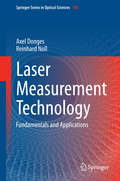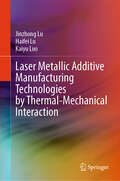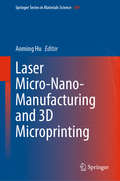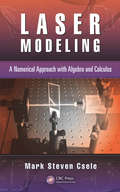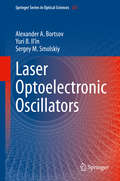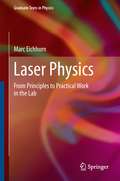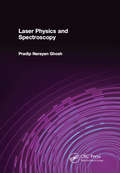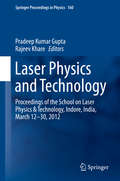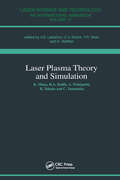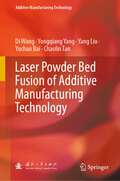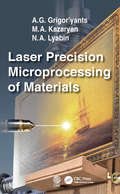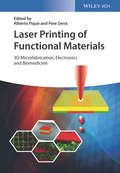- Table View
- List View
Laser Drilling
by Bekir Sami YilbasThis book introduces laser drilling processes including modelling, quality assessment of drilled holes, and laser drilling applications. It provides insights into the laser drilling process and relation among the drilling parameters pertinent to improved end product quality. This book is written for engineers and scientists working on laser machining, particularly laser drilling.
Laser Electrochemistry of Intermediates
by Victor A. Benderskii Alexander V. BenderskiiLaser photoelectron emission not only allows investigation of interfaces between electrodes and solution, but also provides a method for fast generation of intermediate species in the vicinity of the interface and so permits study of their electrode reactions. Laser Electrochemistry of Intermediates presents the first-ever comprehensive review of this important phenomenon and its electrochemical applications.The book explores how the innovative method of laser electron emission from metal electrodes resolves two fundamental problems inherent in current methods of intermediate species (IS) generation and detection: difficulty generating IS quickly in the vicinity of the electrode surface and low IS surface concentration. In addition, for the first time, quasi-free and solvated electrons, hydrogen atoms, simple organic and inorganic radicals, and ions with anomalous valence are systematically studied. Laser Electrochemistry of Intermediates incorporates a unique, two-pronged analytical approach. First, the authors consider the kinetics and thermodynamics of the processes based on the participation of IS in its one-electron stages, thus allowing the assignment of real physical meaning to the electrochemical measurables. Second, they consider electrode reactions side by side with homogeneous reactions of electron transfer, facilitating understanding of the universal theory of electron transfer reactions in polar media as well as the peculiarities of these reactions occurring in the interface between electrode and solution.
Laser Filamentation
by Andre D. Bandrauk Emmanuel Lorin Jerome V. MoloneyThis book is focused on the nonlinear theoretical and mathematical problems associated with ultrafast intense laser pulse propagation in gases and in particular, in air. With the aim of understanding the physics of filamentation in gases, solids, the atmosphere, and even biological tissue, specialists in nonlinear optics and filamentation from both physics and mathematics attempt to rigorously derive and analyze relevant non-perturbative models. Modern laser technology allows the generation of ultrafast (few cycle) laser pulses, with intensities exceeding the internal electric field in atoms and molecules (E=5x109 V/cm or intensity I = 3. 5 x 1016 Watts/cm2 ). The interaction of such pulses with atoms and molecules leads to new, highly nonlinear nonperturbative regimes, where new physical phenomena, such as High Harmonic Generation (HHG), occur, and from which the shortest (attosecond - the natural time scale of the electron) pulses have been created. One of the major experimental discoveries in this nonlinear nonperturbative regime, Laser Pulse Filamentation, was observed by Mourou and Braun in 1995, as the propagation of pulses over large distances with narrow and intense cones. This observation has led to intensive investigation in physics and applied mathematics of new effects such as self-transformation of these pulses into white light, intensity clamping, and multiple filamentation, as well as to potential applications to wave guide writing, atmospheric remote sensing, lightning guiding, and military long-range weapons. The increasing power of high performance computers and the mathematical modelling and simulation of photonic systems has enabled many new areas of research. With contributions by theorists and mathematicians, supplemented by active experimentalists who are experts in the field of nonlinear laser molecule interaction and propagation, Laser Filamentation sheds new light on scientific and industrial applications of modern lasers.
Laser Forming and Welding Processes
by Bekir Sami Yilbas Shahzada Zaman Shuja Sohail AkhtarThis book introduces model studies and experimental results associated with laser forming and welding such as laser induced bending, welding of sheet metals, and related practical applications. The book provides insight into the physical processes involved with laser forming and welding. The analytical study covers the formulation of laser induced bending while the model study demonstrates the simulation of bending and welding processes using the finite element method. Analytical and numerical solutions for laser forming and welding problems are provided.
Laser Fundamentals
by William T. SilfvastLaser Fundamentals provides a clear and comprehensive introduction to the physical and engineering principles of laser operation and design. Simple explanations, based throughout on key underlying concepts, lead the reader logically from the basics of laser action to advanced topics in laser physics and engineering. Much new material has been added to this second edition, especially in the areas of solid-state lasers, semiconductor lasers, and laser cavities. This 2004 edition contains a new chapter on laser operation above threshold, including extensive discussion of laser amplifiers. The clear explanations, worked examples, and many homework problems will make this book invaluable to undergraduate and first-year graduate students in science and engineering taking courses on lasers. The summaries of key types of lasers, the use of many unique theoretical descriptions, and the extensive bibliography will also make this a valuable reference work for researchers.
Laser Heat-Mode Lithography: Principle and Methods (Springer Series in Materials Science #291)
by Jingsong WeiThis book provides a systematic description and analysis of laser heat-mode lithography, addressing the basic principles, lithography system, manipulation of feature size, grayscale lithography, resist thin films, and pattern transfer, while also presenting typical experimental results and applications. It introduces laser heat-mode lithography, where the resist thin films are essentially an opto-thermal response to the laser beam with changeable wavelength and are not sensitive to laser wavelength. Laser heat-mode lithography techniques greatly simplify production procedures because they require neither a particular light source nor a particular environment; further, there are no pre-baking and post-baking steps required for organic photoresists. The pattern feature size can be either larger or smaller than the laser spot by adjusting the writing strategy. The lithographic feature size can also be arbitrarily tuned from nanoscale to micrometer without changing the laser spot size. Lastly, the line edge roughness can be controlled at a very low value because the etching process is a process of breaking bonds among atoms. The book offers an invaluable reference guide for all advanced undergraduates, graduate students, researchers and engineers working in the fields of nanofabrication, lithography techniques and systems, phase change materials, etc.
Laser Heating of Metals
by A. M. ProkhorovIn order to ensure efficient use of lasers, and for any large-scale implementation, a thorough knowledge of the fundamental laws governing the interaction of radiation with matter is required. Laser Heating of Metals provides a systematic and comprehensive presentation of the fundamental principles underlying the physical and chemical mechanisms governing the interaction of laser radiation with solid targets, and in particular metals in gaseous environments, for a wide range of beam parameters. The authors have been active in the field of interactions between lasers and materials for many years, and this book summarises the results of their work, in particular concerning the action of CO2 lasers on metals. These results are then discussed at some length. Laser Heating of Materials will be of interest to scientists at all levels with an interest in the interaction of radiation with condensed matter, and in particular to those involved in laser cutting and welding etc, and metal-working.
Laser Inter-Satellite Links Technology
by Jing Li Jianjun ZhangLASER INTER-SATELLITE LINKS TECHNOLOGY State of the art resource covering key technologies and related theories of inter-satellite links Laser Inter-Satellite Links Technology explores satellite networking as a growing topic in the field of communication technology, introducing the definition, types, and working frequency bands of inter-satellite links, discussing the number of orbital elements of the spacecraft motion state under two-body motion and their conversion relationship, and establishing the basic demand model for inter-satellite link network, chain topology model, and transmission protocol model. The book focuses on the analysis and introduction of the principles and error sources of microwave and laser inter-satellite ranging, including the basic composition, workflow, and constraints of the laser inter-satellite link, and related design principles of the inter-satellite laser transmitter and receivers. Later chapters also discuss theories and methods of acquisition, alignment, and tracking, the impact of alignment errors on performance, and inter-satellite link modulation and its implementation. Specific sample topics covered in Laser Inter-Satellite Links Technology include: Pulse position modulation (PPM), differential pulse position modulation (DPPM), digital pulse interval modulation (DPIM), and double-head pulse interval modulation (DH-PIM) Basic demand model of inter-satellite link network application, including basic configuration of constellations and inter-satellite transmission networks Inter-satellite ranging accuracy, principles of microwave inter-satellite ranging, and analysis of microwave ranging error sources Effect of tracking error on the beam distribution at the receiving end and influence of tracking and pointing error on communication error rate Laser Inter-Satellite Links Technology serves a completely comprehensive resource on the subject and is a must-have reference for experts and scholars in aerospace, along with graduates and senior undergraduates in related programs of study.
Laser Interaction with Biological Material
by Kirill KulikovThis book covers the principles of laser interaction with biological cells and tissues of varying degrees of organization. The problems of biomedical diagnostics are considered. Scattering of laser irradiation of blood cells is modeled for biological structures (dermis, epidermis, vascular plexus). An analytic theory is provided which is based on solving the wave equation for the electromagnetic field. It allows the accurate analysis of interference effects arising from the partial superposition of scattered waves. Treated topics of mathematical modeling are: optical characterization of biological tissue with large-scale and small-scale inhomogeneities in the layers, heating blood vessel under laser irradiation incident on the outer surface of the skin and thermo-chemical denaturation of biological structures at the example of human skin.
Laser Interaction with Heterogeneous Biological Tissue: Mathematical Modeling (Biological and Medical Physics, Biomedical Engineering)
by Kirill Kulikov Tatiana KoshlanThis book introduces readers to the principles of laser interaction with biological cells and tissues with varying degrees of organization. In addition to considering the problems of biomedical cell diagnostics, and modeling the scattering of laser irradiation of blood cells for biological structures (dermis, epidermis, vascular plexus), it presents an analytic theory based on solving the wave equation for the electromagnetic field. It discusses a range of mathematical modeling topics, including optical characterization of biological tissue with large-scale and small-scale inhomogeneities in the layers; heating blood vessels using laser irradiation on the outer surface of the skin; and thermo-chemical denaturation of biological structures based on the example of human skin. In this second edition, a new electrodynamic model of the interaction of laser radiation with blood cells is presented for the structure of cells and the in vitro prediction of optical properties. The approach developed makes it possible to determine changes in cell size as well as modifications in their internal structures, such as transformation and polymorphism nucleus scattering, which is of interest for cytological studies. The new model is subsequently used to calculate the size distribution function of irregular-shape particles with a variety of forms and structures, which allows a cytological analysis of the observed deviations from normal cells.
Laser Machining of Advanced Materials
by Narendra B Dahotre Anoop SamantAdvanced materials are becoming increasingly important as substitutes for traditional materials and as facilitators for new and unique products. They have had a considerable impact on the development of a wide range of strategic technologies. Structural ceramics, biomaterials, composites and intermetallics fall under this category of advanced mater
Laser Material Processing
by Jyotirmoy Mazumder William M. Steen Kenneth G. WatkinsThe informal style of Laser Material Processing (4th Edition) will guide you smoothly from the basics of laser physics to the detailed treatment of all the major materials processing techniques for which lasers are now essential. * Helps you to understand how the laser works and to decide which laser is best for your purposes. * New chapters on laser physics, drilling, micro- and nanomanufacturing and biomedical laser processing reflect the changes in the field since the last edition, updating and completing the range of practical knowledge about the processes possible with lasers already familiar to established users of this well-known text. * Provides a firm grounding in the safety aspects of laser use. * Now with end-of-chapter exercises to help students assimilate information as they learn. * The authors' lively presentation is supported by a number of original cartoons by Patrick Wright and Noel Ford which will bring a smile to your face and ease the learning process.
Laser Materials Processing (Manufacturing Engineering and Materials Processing)
by Leonamrdig LioreThis volume discusses the basic principles necessary to understand lasers, explains laser interactions with materials, and surveys the wide variety of industrial applications of the major laser types, covering in detail the operating mechanisms of carbon dioxide, Nd:YAG, and excimer lasers. It presents lasers as manufacturing tools rather than laboratory devices.
Laser Measurement Technology
by Axel Donges Reinhard NollLaser measurement technology has evolved in the last years in a versatile and reflationary way. Today, its methods are indispensable for research and development activities as well as for production technology. Every physicist and engineer should therefore gain a working knowledge of laser measurement technology. This book closes the gap of existing textbooks. It introduces in a comprehensible presentation laser measurement technology in all its aspects. Numerous figures, graphs and tables allow for a fast access into the matter. In the first part of the book the important physical and optical basics are described being necessary to understand laser measurement technology. In the second part technically significant measuring methods are explained and application examples are presented. Target groups of this textbook are students of natural and engineering sciences as well as working physicists and engineers, who are interested to make themselves familiar with laser measurement technology and its fascinating potentials.
Laser Metallic Additive Manufacturing Technologies by Thermal-Mechanical Interaction
by Jinzhong Lu Kaiyu Luo Haifei LuThis book introduces the laser hybrid additive manufacturing technology (LHAM) with alternately thermal and mechanical effects for the high-performance manufacturing of key components. Metal additive manufacturing (AM) technologies have made considerable progress in the basic theoretical field since its invention in the 1970s. However, there are still some difficulties in the coordinated control of the structure and performance, containing the challenges of “structure control” against deformation and cracking of the formed metallic components incurred by internal stress and “performance control” against poor fatigue property of formed metallic components incurred by metallurgical defects. This book surveys the most relevant papers about the influence of laser shock wave on the microstructural evolution, residual stress, metallurgical defect, and mechanical properties that have become the foundation to elucidate the principles and effects of LHAM technology. This book is separated into four parts to fully present the LHAM technology. The first part reviews the background of LHAM technology. The second part explains the theoretical basis of the thermal effects of laser additive manufacturing (LAM) and mechanical effects of laser shock peening (LSP). The other two parts specifically describe the microstructural evolution, residual stress, metallurgical defect, and mechanical properties using LHAM technology. This book benefits the audience in the field of mechanical engineering and materials sciences, since LHAM technology is suitable for the manufacturing and applications of the key components of aero-engine. The analysis in the book helps the audience deeply understand the mechanism of LHAM technology. The authors’ unique thinking about LHAM technology also runs through the book, which may enlighten the audience to further develop LHAM technology.
Laser Micro-Nano-Manufacturing and 3D Microprinting (Springer Series in Materials Science #309)
by Anming HuThis book provides a comprehensive overview of the latest advances in laser techniques for micro-nano-manufacturing and an in-depth analysis of applications, such as 3D printing and nanojoining. Lasers have gained increasing significance as a precise tool for advanced manufacturing. Written by world leading scientists, the first part of the book presents the fundamentals of laser interaction with materials at the micro- and nanoscale, including multiphoton excitation and nonthermal melting, and allows readers to better understand advanced processing. In the second part, the authors focus on various advanced fabrications, such as laser peening, surface nanoengineering, and plasmonic heating. Finally, case studies are devoted to special applications, such as 3D printing, microfluidics devices, energy devices, and plasmonic and photonic waveguides. This book integrates both theoretical and experimental analysis. The combination of tutorial chapters and concentrated case studies will be critically attractive to undergraduate and graduate students, researchers, and engineers in the relevant fields. Readers will grasp the full picture of the application of laser for micro-nanomanufacturing and 3D printing.
Laser Modeling: A Numerical Approach with Algebra and Calculus
by Mark Steven CseleOffering a fresh take on laser engineering, Laser Modeling: A Numerical Approach with Algebra and Calculus presents algebraic models and traditional calculus-based methods in tandem to make concepts easier to digest and apply in the real world. Each technique is introduced alongside a practical, solved example based on a commercial laser. Assuming some knowledge of the nature of light, emission of radiation, and basic atomic physics, the text: Explains how to formulate an accurate gain threshold equation as well as determine small-signal gain Discusses gain saturation and introduces a novel pass-by-pass model for rapid implementation of "what if?" scenarios Outlines the calculus-based Rigrod approach in a simplified manner to aid in comprehension Considers thermal effects on solid-state lasers and other lasers with new and efficient quasi-three-level materials Demonstrates how the convolution method is used to predict the effect of temperature drift on a DPSS system Describes the technique and technology of Q-switching and provides a simple model for predicting output power Addresses non-linear optics and supplies a simple model for calculating optimal crystal length Examines common laser systems, answering basic design questions and summarizing parameters Includes downloadable Microsoft® Excel™ spreadsheets, allowing models to be customized for specific lasers Don’t let the mathematical rigor of solutions get in the way of understanding the concepts. Laser Modeling: A Numerical Approach with Algebra and Calculus covers laser theory in an accessible way that can be applied immediately, and numerically, to real laser systems.
Laser Optoelectronic Oscillators (Springer Series in Optical Sciences #232)
by Sergey M. Smolskiy Alexander A. Bortsov Yuri B. Il’inThis book is devoted to the theoretical and experimental investigation of the optoelectronic oscillator (OEO) with direct and external modulation of laser emission. Such devices, sources of precision radio frequency oscillations using laser excitation, are novel and technologically relevant, with manifold possible applications. The book includes a review of the present state of the theory and generation techniques in microwave and mm-wave ranges for traditional and optoelectronic oscillators, description of OEO construction and operation principles, theoretical oscillation analysis and mathematical description of the relevant semi-classical laser physics, and investigation of the power spectral density of noises. Technical features and advantages of OEOs with external and direct modulation of laser emission are discussed together with functional diagrams. The characteristics of OEOs are compared with other traditional RF oscillators, such as quartz, surface acoustic waves, and oscillators with electromagnetic wave cavities. Special attention is paid to Q-factors and phase noises of RF carriers at small offsets. The authors discuss the technical characteristics of modern optoelectronic methods for precision RF oscillation formation, such as commercial large-dimension and compact quantum frequency standards with optical pumping on cesium and rubidium cells. This book is aimed at scientists and engineers in academia and industry who work with sources of microwave and mm-wave signals.
Laser Physics
by Marc EichhornThis textbook originates from a lecture course in laser physics at the Karlsruhe School of Optics and Photonics at the Karlsruhe Institute of Technology (KIT). A main goal in the conception of this textbook was to describe the fundamentals of lasers in a uniform and especially lab-oriented notation and formulation as well as many currently well-known laser types, becoming more and more important in the future. It closes a gap between the measureable spectroscopic quantities and the whole theoretical description and modeling. This textbook contains not only the fundamentals and the context of laser physics in a mathematical and methodical approach important for university-level studies. It allows simultaneously, owing to its conception and its modern notation, to directly implement and use the learned matter in the practical lab work. It is presented in a format suitable for everybody who wants not only to understand the fundamentals of lasers but also use modern lasers or even develop and make laser setups. This book tries to limit prerequisite knowledge and fundamental understanding to a minimum and is intended for students in physics, chemistry and mathematics after a bachelor degree, with the intention to create as much joy and interest as seen among the participants of the corresponding lectures. This university textbook describes in its first three chapters the fundamentals of lasers: light-matter interaction, the amplifying laser medium and the laser resonator. In the fourth chapter, pulse generation and related techniques are presented. The fifth chapter gives a closing overview on different laser types gaining importance currently and in the future. It also contains a set of examples on which the theory learned in the first four chapters is applied and extended.
Laser Physics and Spectroscopy
by Pradip Narayan GhoshIn this book emphasis is laid on laser including its operation, different types, properties like coherence and monochromaticity, beam propagation, theoretical treatment of atom‐field interaction, semi‐classical laser theory, non‐linear effects, quantum properties, photon concept and coherent states etc. Please note: Taylor & Francis does not sell or distribute the Hardback in India, Pakistan, Nepal, Bhutan, Bangladesh and Sri Lanka.
Laser Physics and Technology
by Pradeep Kumar Gupta Rajeev KhareThe book, 'Laser Physics and Technology', addresses fundamentals of laser physics, representative laser systems and techniques, and some important applications of lasers. The present volume is a collection of articles based on some of the lectures delivered at the School on 'Laser Physics and Technology' organized at Raja Ramanna Centre for Advanced Technology during March, 12-30, 2012. The objective of the School was to provide an in-depth knowledge of the important aspects of laser physics and technology to doctoral students and young researchers and motivate them for further work in this area. In keeping with this objective, the fourteen chapters, written by leading Indian experts, based on the lectures delivered by them at the School, provide along with class room type coverage of the fundamentals of the field, a brief review of the current status of the field. The book will be useful for doctoral students and young scientists who are embarking on a research in this area as well as to professionals who would be interested in knowing the current state of the field particularly in Indian context.
Laser Plasma Theory and Simulation (Laser Science And Technology Ser.)
by Hector A. BaldisThis book covers recent developments in laser plasma physics such as absorption, instability, energy transport and radiation from the standpoint of theory and simulation for plasma corona, showing how the elements for the high density compression depend on the interaction physics and heat transport.
Laser Powder Bed Fusion of Additive Manufacturing Technology (Additive Manufacturing Technology)
by Yang Liu Di Wang Yuchao Bai Yongqiang Yang Chaolin TanThis book systematically introduces the powder bed laser melting technology and its application and summarizes the author's team's experience in scientific research, engineering development, and data accumulation in recent 15 years. It includes in-depth theoretical analysis and a lot of engineering experience in equipment debugging, process development, and material testing. The book takes the powder bed laser melting technology as the object and divides the content into 15 chapters. It is used as technical learning materials for researchers and engineering development personnel engaged in metal 3D printing.
Laser Precision Microprocessing of Materials
by M. A. Kazaryan A. G. Grigor'Yants N. A. LyabinThis reference focuses on the current state of fundamental research and industrial achievements in the field of precision laser processing of a wide range of metal, semiconductor and dielectric materials. The possibilities of microprocessing by pulsed nanosecond laser radiation and copper vapor laser systems are analyzed. Design and operation principles, ways to increase their efficiency and reliability, and a series of modern automated technological installations are described. The work will be of interest to specialists, engineers, students and graduate students working and studying in the field of laser technology and optics, laser and information technology.
Laser Printing of Functional Materials: 3D Microfabrication, Electronics and Biomedicine
by Alberto Piqué Pere SerraThe first book on this hot topic includes such major research areas as printed electronics, sensors, biomaterials and 3D cell printing. Well-structured and with a strong focus on applications, the text is divided in three sections with the first describing the fundamentals of laser transfer. The second provides an overview of the wide variety of materials that can be used for laser transfer processing, while the final section comprehensively discusses a number of practical uses, including printing of electronic materials, printing of 3D structures as well as large-area, high-throughput applications. The whole is rounded off by a look at the future for laser printed materials. Invaluable reading for a broad audience ranging from material developers to mechanical engineers, from academic researchers to industrial developers and for those interested in the development of micro-scale additive manufacturing techniques.

